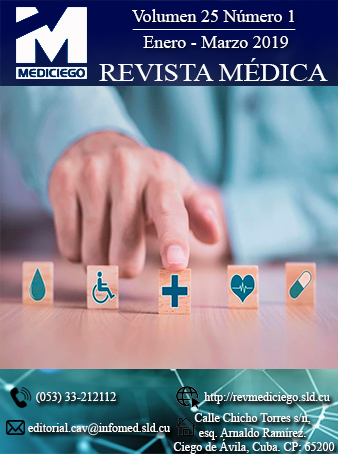Severe corneal ulcer secondary to rheumatoid arthritis
Abstract
Introduction: rheumatoid arthritis is a multisystemic, inflammatory, chronic disease of unknown origin. Approximately 20-35 % of patients who suffer from it present ocular manifestations.
Objective: to describe the characteristics of secondary severe corneal ulcer to rheumatoid arthritis in a patient.
Case presentation: female patient, 50 years old, with a history of rheumatoid arthritis and severe keratoconjunctivitis sicca. She presented a 4 mm inferotemporal paracentral corneal ulcerative lesion that affected the stroma of the right eye. The sample taken for direct examination and culture was positive for Staphylococcus aureus. She was treated with fortified broad-spectrum antibiotics, non-steroidal anti-inflammatory and mydriatic anti-inflammatory eye drops. Subsequently, an overlying fungal infection and central descemetocele with perforation emerged. She underwent therapeutic tectonic penetrating keratoplasty, and retransplanted seven days later. She presented rejection to the graft with opacification of the transplant and total cataract. She is currently awaiting the performance of optical penetrating keratoplasty and cataract surgery with intraocular lens implant, to restore corneal transparency and improve visual acuity.
Conclusions: the corneal ulcerative lesion presented by the patient is frequent in patients with rheumatoid arthritis. In her case, as in the majority, there was no favorable response to treatment, so she should undergo optical penetrating keratoplasty and cataract surgery with intraocular lens implantation. The early treatment of ocular affections contributes to improve the visual prognosis of the patient, for which it is recommended to formalize the periodic ophthalmological study to all patients diagnosed with rheumatoid arthritisDownloads
Published
How to Cite
Issue
Section
License
Copyright (c) 2021 Karyna Castro Cárdenas, Aylín Espinosa Gómez, Enrique Cossío González

This work is licensed under a Creative Commons Attribution-NonCommercial 4.0 International License.
Those authors who have publications with this journal accept the following terms of the License CC Attribution-NonCommercial 4.0 International (CC BY-NC 4.0):
You are free to:
- Share — copy and redistribute the material in any medium or format for any purpose, even commercially.
- Adapt — remix, transform, and build upon the material for any purpose, even commercially.
The licensor cannot revoke these freedoms as long as you follow the license terms.
Under the following terms:
- Attribution — You must give appropriate credit , provide a link to the license, and indicate if changes were made . You may do so in any reasonable manner, but not in any way that suggests the licensor endorses you or your use
- No additional restrictions — You may not apply legal terms or technological measures that legally restrict others from doing anything the license permits.
The journal is not responsible for the opinions and concepts expressed in the works, which are the exclusive responsibility of the authors. The Editor, with the assistance of the Editorial Committee, reserves the right to suggest or request advisable or necessary modifications. Original scientific works are accepted for publication, as are the results of research of interest that have not been published or sent to another journal for the same purpose.
The mention of trademarks of specific equipment, instruments or materials is for identification purposes, and there is no promotional commitment in relation to them, neither by the authors nor by the editor.






















